The Mandalorian's Pandemic Innovation
Pandemic Minute: The Mandalorian delivers more than just the Child
The first season of The Mandalorian, Disney’s massive Star Wars hit, premiered on November 12, 2019. The shows, and the baby Yoda memes, were a runaway hit. Then the world shut down, grounding plans to travel anywhere, much less a galaxy far, far away! Disney’s solution, a nascent technology called Stagecraft, catapulted its (many) Star Wars series to new heights of special effects success.
Previously, to capture an other-worldly landscape, filmmakers either had to go to remote locations- such as Death Valley (The National Park Service invites you to visit Tatooine!)- or resort to green screen, where actors film a scene with minimal environmental cues and digital landscapes are added later. The former is often preferred from a visual effects (and acting) standpoint, although more expensive.
However, the costs of on-location filming skyrocketed during the pandemic. Travel was difficult and moving actors and crew across multiple locations was bad for infection risk. But these sudden barriers to filming on location led to a cinematic breakthrough. The reason green screen is so visually disappointing is that the camera cannot move through a scene. Once the camera changes location on the set, the flat background becomes apparent. However, with other avenues cut off in 2020, producers at The Mandalorian homed in on improving a new technology, called StageCraft, which surrounds in-studio actors with large high-definition video walls. Filmmakers digitally record a complete location, and then dynamically project this location onto the walls in a way that changes with the camera. The result is a high definition, responsive, but totally digital background. Summoning the resources and technology to handle real-time 3-D computer rendering became worthwhile when other alternatives became expensive and risky.[1]

[1] Check out the StageCraft discussion from The Mandalorian Directors





